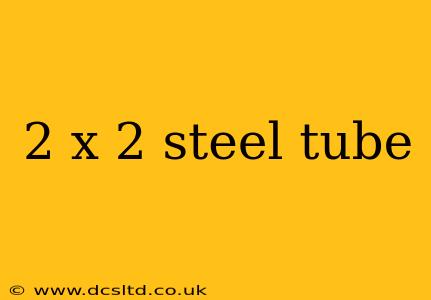Steel tubes, specifically those with a 2 x 2 inch profile, are versatile components used extensively in various industries. Their strength, durability, and relative affordability make them ideal for a wide range of applications. This guide delves into the specifics of 2 x 2 steel tubes, exploring their properties, uses, and considerations for selection.
What are the Different Types of 2 x 2 Steel Tubes?
The term "2 x 2 steel tube" can encompass several variations. The key differences lie in the wall thickness and the type of steel used. A thicker wall signifies greater strength and load-bearing capacity. Common steel types include:
- Mild Steel: This is a cost-effective option, offering good strength for general applications.
- High-Strength Low-Alloy Steel (HSLA): HSLA steel provides higher strength-to-weight ratios compared to mild steel, making it suitable for structural applications where weight is a concern.
- Stainless Steel: Known for its corrosion resistance, stainless steel 2 x 2 tubes are ideal for outdoor or harsh environments. However, they are generally more expensive than mild or HSLA steel.
The dimensions are also crucial. The "2 x 2" refers to the outer dimensions of the square tube. The inner dimensions will be smaller, determined by the wall thickness. You'll typically find this information specified as "2 x 2 x [wall thickness]," e.g., "2 x 2 x 1/8" inch.
What is the Weight of a 2 x 2 Steel Tube?
The weight of a 2 x 2 steel tube varies significantly depending on the length and wall thickness. A thicker wall naturally results in a heavier tube. Steel density also plays a role—stainless steel, for example, is denser than mild steel. Precise weight calculations require knowing the specific dimensions and the type of steel used. Manufacturers' websites or online calculators can provide accurate weight estimations based on these parameters.
What are the Common Uses of 2 x 2 Steel Tubes?
The versatility of 2 x 2 steel tubes leads to a wide array of applications:
- Structural Frameworks: They form the basis of many structures, from small-scale projects like furniture and handrails to larger-scale applications in construction and industrial settings.
- Guardrails and Fencing: Their strength and durability make them suitable for creating secure and robust guardrails and fencing systems.
- Automotive and Machinery: 2 x 2 steel tubes are frequently used in the manufacturing of automotive components, machinery frames, and other industrial equipment.
- Art and Fabrication: Artists and fabricators utilize these tubes for creating unique sculptures, furniture pieces, and decorative elements.
How Much Does a 2 x 2 Steel Tube Cost?
The cost of a 2 x 2 steel tube is highly variable, dependent on several factors:
- Steel Type: Stainless steel is significantly more expensive than mild or HSLA steel.
- Wall Thickness: Thicker walls cost more due to increased material usage.
- Length: Longer tubes generally cost more per unit length.
- Supplier: Prices can vary among different steel suppliers and distributors.
- Quantity Purchased: Bulk purchases often come with discounts.
It's recommended to contact local steel suppliers for current pricing information, providing the specific dimensions and quantity required for an accurate quote.
Where Can I Buy 2 x 2 Steel Tube?
2 x 2 steel tubes are widely available from various sources:
- Steel Suppliers and Distributors: These are your primary source, often offering a wide selection of sizes, steel types, and quantities.
- Online Retailers: Many online retailers sell steel tubes, offering convenience but potentially higher shipping costs.
- Local Metal Shops: These shops can offer cutting and other fabrication services, adding convenience to your project.
Remember to check reviews and compare prices before making your purchase.
What is the Difference Between a 2 x 2 Steel Tube and a 2 x 2 Steel Square Bar?
While both are square-shaped, there's a key difference: a steel tube is hollow, while a steel square bar is solid. Tubes offer a higher strength-to-weight ratio, making them more efficient for many structural applications. Square bars might be preferred in situations demanding high compressive strength and rigidity, even though they are heavier.
This guide provides a comprehensive overview of 2 x 2 steel tubes. For specific applications or detailed specifications, consulting with a structural engineer or a steel supplier is always advisable.
